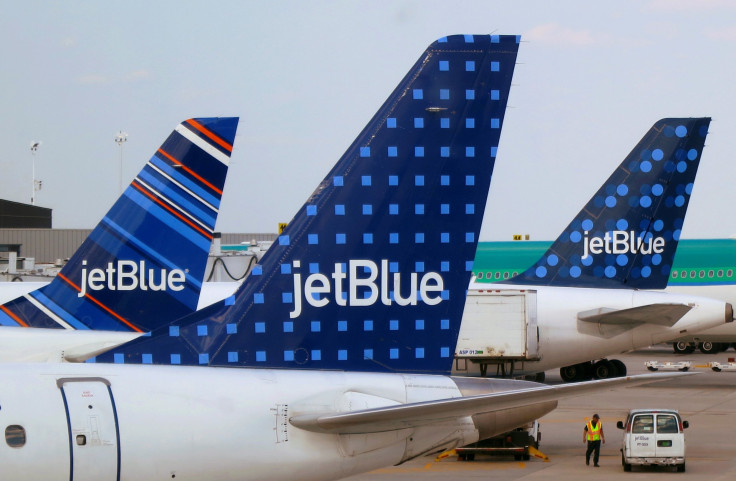JetBlue Stock Is Surging In June: Here's Why
2018 was a dismal year for JetBlue Airways (NASDAQ:JBLU) shareholders. JetBlue stock plunged 28% last year, as investors fretted over cost increases related to a pilot contract that was implemented last August. Investors also worried about rising fuel prices for much of the year, until those concerns were replaced by even bigger fears of an economic slowdown near year-end.
However, JetBlue shares are bouncing back in 2019. In fact, the stock has surged 12% just since the beginning of June, pushing JetBlue's year-to-date gain to 20%.
Let's take a look at why investors are finally warming to JetBlue stock again -- and why there could be further gains in store for shareholders over the next year or two.
Fuel prices are moderating
A retreat in oil prices is one factor supporting JetBlue stock's recent recovery. Back in January, JetBlue estimated that it would pay $2.01 per gallon for jet fuel in the first quarter, which would have been down modestly from $2.09 per gallon a year earlier. However, fuel prices rose steadily in the first few months of 2019. As a result, JetBlue ultimately reported an average fuel price of $2.05 per gallon for the quarter -- still down year over year, but not by as much.
Moreover, JetBlue's initial outlook for the second quarter, published in April, called for an average jet fuel price of $2.21 per gallon, up $0.16 sequentially. (That still would have been lower than its Q2 2018 average fuel price of $2.28 per gallon, though.)
Since then, airlines have gotten significant relief on the fuel cost front, as oil prices began to plunge in mid-May. The benchmark price of jet fuel -- which doesn't include taxes and transportation costs that airlines must pay -- has fallen from $2.07 per gallon on May 16 to consistently less than $1.80 per gallon in June.
If oil prices were to remain where they currently stand, JetBlue would likely pay $2.00 per gallon or less for jet fuel in the third quarter, compared to $2.32 per gallon a year earlier. That would provide $75 million or more of savings in the third quarter alone.
JetBlue stock just got a big upgrade
Falling oil prices are one big reason why JetBlue snared an upgrade on Wall Street this week. Analyst Kevin Crissey of Citi raised his rating on JetBlue stock to "buy" and boosted his target price by 33%, to $26, noting the potential for cost trends to become much more favorable.
Aside from the improving fuel cost trend, JetBlue's nonfuel unit cost growth is finally decelerating. In April, JetBlue CFO Steve Priest said that the company had secured annualized cost reductions of $224 million under its multiyear structural cost program. Some of that savings won't kick in until later this year or in 2020.
Additionally, JetBlue's initiative to add two rows of seats to each of its Airbus A320s is finally gaining speed. JetBlue expects that effort to boost earnings per share by $0.10 to $0.15, with the biggest piece of the benefit now set to show up next year.
Between lower fuel prices and these cost initiatives, JetBlue is on track to achieve a significant reduction in its unit costs in the second half of 2019 and in 2020. As a result, Crissey (the Citi analyst) believes the company has a good chance to achieve its 2020 EPS guidance range of $2.50 to $3.00 even with no unit revenue growth. Adjusted EPS was just $1.55 in 2018.
The unit revenue outlook seems just fine
In effect, Crissey is urging shareholders not to worry too much about the risk of a unit revenue slowdown. JetBlue has enough cost reduction levers to drive strong earnings growth even if revenue per available seat mile (RASM) trends weaken.
Fortunately, there's no sign that investors actually need to worry about JetBlue's unit revenue trajectory. On Wednesday, the carrier said that it expects RASM to rise 2% to 4% this quarter. This represents a slight improvement relative to its initial forecast for 1% to 4% RASM growth.
To be fair, this guidance includes a roughly 2.25 percentage point tailwind from holiday timing, so JetBlue's underlying unit revenue trajectory right now is barely positive. That said, JetBlue intends to roll out its version of "basic economy" fares later this year, improving its ability to match rivals' fares while still getting less-price-sensitive customers to pay more. This strategy has driven significant unit revenue improvements at other airlines.
Thus, JetBlue is well positioned to reach -- and possibly even exceed -- its 2020 EPS target, thanks to a combination of unit cost reductions and modest RASM growth. In that context, it's not surprising that JetBlue stock is rising again. And with the shares still trading for less than eight times the low end of management's 2020 EPS forecast, there's plenty of room for JetBlue stock to keep moving higher.
This article originally appeared in The Motley Fool.
Adam Levine-Weinberg owns shares of JetBlue Airways. The Motley Fool recommends JetBlue Airways. The Motley Fool has a disclosure policy.












